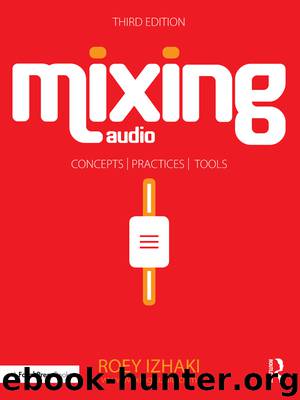Mixing Audio by Izhaki Roey

Author:Izhaki, Roey [Неизв.]
Language: eng
Format: epub
Publisher: Taylor & Francis (CAM)
Figure 17.11 The effect of different attack and release settings on a waveform. (a) The original levels before compression. (b–e) The resultant levels after compression.
Figure 17.11 shows the effect of different attack and release settings on a waveform. On all graphs, the ratio is 2:1, and the threshold is set to 6 dB. The original input signal (a) rises instantly from 6 to 12 dB, then drops instantly back to 6 dB. In all cases the overshoot amount is 6 dB, so with the 2:1 ratio the full gain reduction amount is 3 dB. We can see in (b) that if there is no attack and no release, the overshooting signal is constantly reduced by 3 dB. When there is some attack and release (c–e), it takes some time before full gain reduction is reached and then some time before gain reduction ceases. It is worth noting what happens when the release is set and the original signal drops from 12 dB back to 6 dB. Initially, there is still 3 dB of gain reduction, so the original signal is still attenuated to 3 dB below its original level. Slowly, the gain reduction diminishes and only after the release period has passed does the original signal return to 6 dB. This is the first exception for signals below the threshold being reduced in level. The gain reduction graph below (d) helps us to understand why this happens.
Some compressors offer an auto attack or auto release. When either is engaged, the compressor determines the attack or release times automatically. Mostly, this is achieved by the compressor observing the difference between the peak and RMS levels of the side- chain signal. It is worth knowing that in auto mode, neither the attack nor the release is constant (like when we dial the settings manually). Instead, both change in relation to the momentary level of the input signal. For example, a snare hit might produce a faster release than a xylophone note. Thus, auto attack and release do not provide less control—they simply provide an alternative kind of control. Auto release, on respected compressors at least, has a good reputation.
Download
This site does not store any files on its server. We only index and link to content provided by other sites. Please contact the content providers to delete copyright contents if any and email us, we'll remove relevant links or contents immediately.
| Automotive | Engineering |
| Transportation |
Whiskies Galore by Ian Buxton(41525)
Introduction to Aircraft Design (Cambridge Aerospace Series) by John P. Fielding(32885)
Small Unmanned Fixed-wing Aircraft Design by Andrew J. Keane Andras Sobester James P. Scanlan & András Sóbester & James P. Scanlan(32570)
Craft Beer for the Homebrewer by Michael Agnew(17930)
Turbulence by E. J. Noyes(7695)
The Complete Stick Figure Physics Tutorials by Allen Sarah(7135)
Kaplan MCAT General Chemistry Review by Kaplan(6591)
The Thirst by Nesbo Jo(6432)
Bad Blood by John Carreyrou(6271)
Modelling of Convective Heat and Mass Transfer in Rotating Flows by Igor V. Shevchuk(6219)
Learning SQL by Alan Beaulieu(6031)
Weapons of Math Destruction by Cathy O'Neil(5825)
Man-made Catastrophes and Risk Information Concealment by Dmitry Chernov & Didier Sornette(5644)
Digital Minimalism by Cal Newport;(5388)
Life 3.0: Being Human in the Age of Artificial Intelligence by Tegmark Max(5182)
iGen by Jean M. Twenge(5158)
Secrets of Antigravity Propulsion: Tesla, UFOs, and Classified Aerospace Technology by Ph.D. Paul A. Laviolette(4984)
Design of Trajectory Optimization Approach for Space Maneuver Vehicle Skip Entry Problems by Runqi Chai & Al Savvaris & Antonios Tsourdos & Senchun Chai(4837)
Electronic Devices & Circuits by Jacob Millman & Christos C. Halkias(4743)
